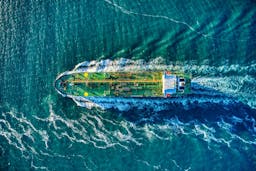/ Global Trend in Green Finance by Financial Institutions
Global Trend in Green Finance by Financial Institutions

What is Green Finance? The United Nations Environment Programme defines green finances aim being to increase the level of financial flows (from banking, micro-credit, insurance and investment) from the public, private and not-for-profit sectors to sustainable development priorities.
According to Forbes, going green is no longer just a buzzword for businesses seeking to capitalize from social cred. It’s a stand-alone concept and one in which more and more companies are taking an interest. In 2021, green finance hit a market value of $540.6 billion, up from just $5.2 billion in 2012, showing exponential market growth.
In late 2021 accountancy firm Deloitte noted that since May 2018, new funding directed to shipping organisations based on ESG indicators has amounted to approximately US$14.5 billion.
We ask Mike Abbott on his views of the global green ship financing.
Mike’s a seasoned board level executive and brings a wealth of experience in commerce, finance, commodities, and shipping. With a professional accreditation as a Chartered Certified Accountant (FCCA) and a BA with Honours degree from the University of London, Mike has also served as the CFO of the Petredec Group, a leading gas trading and shipping company.
What does that mean for a ship owner looking to buy a new ship or to refinance an old ship?
Owners need to understand that eventually all finance will become “green”. There won’t be finance offered that does not include ESG as an integral part of the credit approval process. This will naturally include emissions so far as ship finance is concerned.
Owners should be prepared to demonstrate not only that they technically manage their ships to a high standard, but that they are commercially employed and operated in an environmentally responsible manner. Fixing out a ship to a charterer or trade that is known to have a historically poor emissions profile, and then arguing that it’s “nothing to do with us” may no longer be acceptable.
How can ship owners take a more proactive approach with regards to green financing?
Owners that work hard to minimise their carbon footprint should push their lenders on pricing. Obviously ESG will only ever be a part of the credit approval process, but it must become an important part of it. If there are two owners with a similar financial credit risk profile, but where one is much further along their decarbonisation journey than the other, then it should be equitable that their relative pricing should include a delta to reflect this.
From the maritime financial institutions’ perspective, showing that they differentiate their borrowers on ESG, and reward / penalise as appropriate, should also help them to build their own ESG credentials. There’s lots of work to do here, by borrowers and lenders alike.
How you do you think the maritime industry should look at ESG holistically?
It will be incredibly difficult to accurately record the whole life ESG tariff of ocean-going ships that typically spend a couple of decades traversing the globe. The key is digitalisation as this will open the silos of data that we all know exist out there but are often inaccessible.
As an industry we’re often quite poor at being “joined up”. Whilst this may seem like yet another burden/ cost for the typical owner to carry, it’s important to note that better data often yields better decision making which yields better commercial performance, so think of it as an investment not a cost!
In Summary
The pivotal solution lies in digitalisation, as it holds the potential to break down the data barriers that exist and as an industry, we have to work together to have better connectivity to track a ships emissions. From the standpoint of maritime finance, considerable efforts are required from both borrowers and lenders to make meaningful efforts toward environmental sustainability. Lastly, the “it’s not our concern” attitude will very much be trying to steam against these changing tides.
If you would like to know how Vasco Systems can help in your Maritime ESG mandate, feel free to reach out to info@vascosystems.com.








